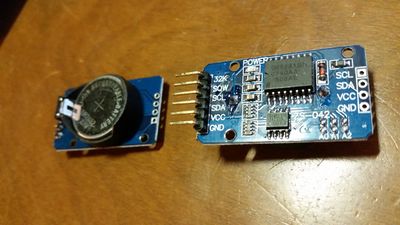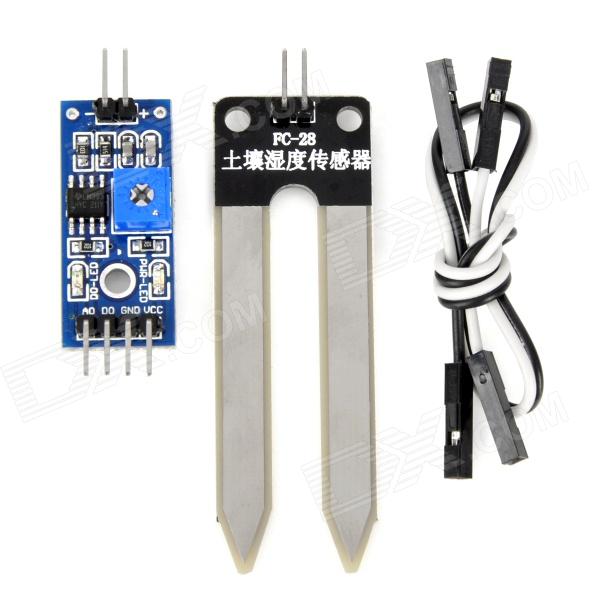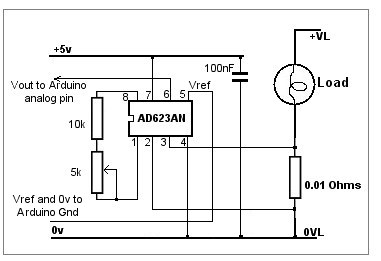Arduino Projects of note: Difference between revisions
No edit summary |
|||
| (23 intermediate revisions by the same user not shown) | |||
| Line 13: | Line 13: | ||
I have some zs-042 RTC , it has a DS3231 RTC and what looks like an ATmega32 on it. | I have some zs-042 RTC , it has a DS3231 RTC and what looks like an ATmega32 on it. | ||
[[Image:20141201_214606.jpg|400px]] | |||
https://edwardmallon.wordpress.com/2014/05/21/using-a-cheap-3-ds3231-rtc-at24c32-eeprom-from-ebay/ very good writing. also notes on using the eeprom are linked. | |||
http://misclab.umeoce.maine.edu/boss/Arduino/bensguides/DS3231_Arduino_Clock_Instructions.pdf <- this worked. | |||
used this: https://github.com/JChristensen/DS3232RTC ( worked ) | |||
[[ | also on board "AT24C32 EEPROM" https://breadboardtronics.wordpress.com/2013/08/27/at24c32-eeprom-and-arduino/ ... a place to store data. | ||
[[/rtc set]] | |||
== LCD == | == LCD == | ||
| Line 26: | Line 36: | ||
== Voltage Comparator Based Sensor == | == Voltage Comparator Based Sensor == | ||
Picked up a soil moisture sensor: | Picked up a soil moisture sensor from Deal Extreme ad 2.23 USD$ | ||
http://www.dx.com/p/soil-humidity-moisture-detection-sensor-module-blue-black-white-200142 | |||
[[Image:sku_200142_1.jpg]] | [[Image:sku_200142_1.jpg]] | ||
| Line 41: | Line 53: | ||
LM 393 Datasheet:<br> | LM 393 Datasheet:<br> | ||
http://www.ti.com.cn/cn/lit/ds/symlink/lm293-n.pdf | http://www.ti.com.cn/cn/lit/ds/symlink/lm293-n.pdf | ||
This chip is a voltage comparator. | |||
The board has d0 digital out and A0 Analog out. | |||
Using the variable potetiomenter you can set the threshold where D0 goes high ( presmably ). | |||
this is a good exmaple of how to "do" this circuit. https://www.mysensors.org/build/light-lm393 | |||
== From analog to digital == | |||
So you got a bunch of cheap sensors, but they are all voltage oriented, like lm 939 and tmp36 and lm35, but you want to hook up a pile of them. wouldn't it be great if you could "convert" the voltage changing sensors to 1 wire or I2C ? | |||
By using a buss ( like I2C ) you can attach many sensors to a single pair of arduino digital pins. | |||
You can! Some notes so far below. | |||
=== Analog to I2C === | |||
http://www.ti.com/lit/ds/symlink/ads1000-q1.pdf | |||
=== I2C What resistor === | |||
http://electronics.stackexchange.com/questions/1849/is-there-a-correct-resistance-value-for-i2c-pull-up-resistors | |||
level shifting : http://playground.arduino.cc/Main/I2CBi-directionalLevelShifter | |||
=== one I2C device many outputs === | |||
* pca9685 ic | |||
== Working with data structure and EEProm == | |||
http://playground.arduino.cc/Code/EEPROMWriteAnything | |||
http://arduino.cc/en/Reference/EEPROMRead | |||
== Measurting electrical usage with arduino == | |||
== Amps with Arduino == | |||
* Reference document: http://www.vwlowen.co.uk/arduino/current/current.htm | |||
* use 0.01 Ohm Shunt resistor | |||
* arduino can measure 0 to 5 v in 4.9 mVa resolution. ( 1024 setps ) | |||
* use op amp AD623ANZ to get volts up for arduino measurement. | |||
== YHDC SCT013-000 CT == | |||
measure amp and volts, non-invasively | |||
https://www.poweruc.pl/blogs/news/non-invasive-sensor-yhdc-sct013-000-ct-used-with-arduino-sct-013 | |||
[[Image:opamp.jpg]] | |||
== multi tasking == | |||
https://learn.adafruit.com/multi-tasking-the-arduino-part-1/a-clean-sweep | |||
== other projects == | |||
;Simple AD8307 rf power meter for sweeper using ad9850 dds and arduino for testing crystals etc | |||
:http://blog.riyas.org/2015/04/a-simple-standalone-antenna-analyzer-with-ili9341tft.html | |||
== My Projects == | |||
* [[/Sun Tracker]] | |||
* [[/Thermostat]] | |||
* [[/datalogger_sdcard]] | |||
* [[Arduino]] | |||
[[Category: Electronics]] | |||
[[Category: Arduino]] | |||
[[Category: ESP]] | |||
Latest revision as of 23:04, 26 October 2024
- cheap good rtc http://www.dx.com/p/ds3231-high-precision-real-time-clock-module-blue-3-3-5-5v-222910#.VGg-R_nF98E
RTC
I have some zs-042 RTC , it has a DS3231 RTC and what looks like an ATmega32 on it.
https://edwardmallon.wordpress.com/2014/05/21/using-a-cheap-3-ds3231-rtc-at24c32-eeprom-from-ebay/ very good writing. also notes on using the eeprom are linked.
http://misclab.umeoce.maine.edu/boss/Arduino/bensguides/DS3231_Arduino_Clock_Instructions.pdf <- this worked.
used this: https://github.com/JChristensen/DS3232RTC ( worked )
also on board "AT24C32 EEPROM" https://breadboardtronics.wordpress.com/2013/08/27/at24c32-eeprom-and-arduino/ ... a place to store data.
LCD
Liquid Crystal Display
Some notes:
Voltage Comparator Based Sensor
Picked up a soil moisture sensor from Deal Extreme ad 2.23 USD$
http://www.dx.com/p/soil-humidity-moisture-detection-sensor-module-blue-black-white-200142
It's based on a lm393 voltage comaparator. Many variation exist, for things like sound and light aswell.
This is an analog to digital sensor NOT a 1 wire sensor, so it soaks up an analog pin.
Resources:
Arduino Code example:
http://arduino-info.wikispaces.com/Brick-LightSensor-Analog-Digital
LM 393 Datasheet:
http://www.ti.com.cn/cn/lit/ds/symlink/lm293-n.pdf
This chip is a voltage comparator.
The board has d0 digital out and A0 Analog out.
Using the variable potetiomenter you can set the threshold where D0 goes high ( presmably ).
this is a good exmaple of how to "do" this circuit. https://www.mysensors.org/build/light-lm393
From analog to digital
So you got a bunch of cheap sensors, but they are all voltage oriented, like lm 939 and tmp36 and lm35, but you want to hook up a pile of them. wouldn't it be great if you could "convert" the voltage changing sensors to 1 wire or I2C ?
By using a buss ( like I2C ) you can attach many sensors to a single pair of arduino digital pins.
You can! Some notes so far below.
Analog to I2C
http://www.ti.com/lit/ds/symlink/ads1000-q1.pdf
I2C What resistor
level shifting : http://playground.arduino.cc/Main/I2CBi-directionalLevelShifter
one I2C device many outputs
- pca9685 ic
Working with data structure and EEProm
http://playground.arduino.cc/Code/EEPROMWriteAnything
http://arduino.cc/en/Reference/EEPROMRead
Measurting electrical usage with arduino
Amps with Arduino
- Reference document: http://www.vwlowen.co.uk/arduino/current/current.htm
- use 0.01 Ohm Shunt resistor
- arduino can measure 0 to 5 v in 4.9 mVa resolution. ( 1024 setps )
- use op amp AD623ANZ to get volts up for arduino measurement.
YHDC SCT013-000 CT
measure amp and volts, non-invasively
https://www.poweruc.pl/blogs/news/non-invasive-sensor-yhdc-sct013-000-ct-used-with-arduino-sct-013
multi tasking
https://learn.adafruit.com/multi-tasking-the-arduino-part-1/a-clean-sweep
other projects
- Simple AD8307 rf power meter for sweeper using ad9850 dds and arduino for testing crystals etc
- http://blog.riyas.org/2015/04/a-simple-standalone-antenna-analyzer-with-ili9341tft.html


